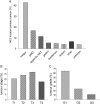Screening for malnutrition in patients with gastro-entero-pancreatic neuroendocrine tumours: a cross-sectional study
- PMID: 27147385
- PMCID: PMC4861125
- DOI: 10.1136/bmjopen-2015-010765
Screening for malnutrition in patients with gastro-entero-pancreatic neuroendocrine tumours: a cross-sectional study
Abstract
Objectives: To investigate whether screening for malnutrition using the validated malnutrition universal screening tool (MUST) identifies specific characteristics of patients at risk, in patients with gastro-entero-pancreatic neuroendocrine tumours (GEP-NET).
Design: Cross-sectional study.
Setting: University Hospitals Coventry & Warwickshire NHS Trust; European Neuroendocrine Tumour Society Centre of Excellence.
Participants: Patients with confirmed GEP-NET (n=161) of varying primary tumour sites, functioning status, grading, staging and treatment modalities.
Main outcome measure: To identify disease and treatment-related characteristics of patients with GEP-NET who score using MUST, and should be directed to detailed nutritional assessment.
Results: MUST score was positive (≥1) in 14% of outpatients with GEP-NET. MUST-positive patients had lower faecal elastase concentrations compared to MUST-negative patients (244±37 vs 383±20 µg/g stool; p=0.018), and were more likely to be on treatment with long-acting somatostatin analogues (65 vs 38%, p=0.021). MUST-positive patients were also more likely to have rectal or unknown primary NET, whereas, frequencies of other GEP-NET including pancreatic NET were comparable between MUST-positive and MUST-negative patients.
Conclusions: Given the frequency of patients identified at malnutrition risk using MUST in our relatively large and diverse GEP-NET cohort and the clinical implications of detecting malnutrition early, we recommend routine use of malnutrition screening in all patients with GEP-NET, and particularly in patients who are treated with long-acting somatostatin analogues.
Keywords: MUST malnutrition universal screening tool; exocrine pancreatic insufficiency; malnutrition; neuroendocrine tumours; somatostatin analogues.
Published by the BMJ Publishing Group Limited. For permission to use (where not already granted under a licence) please go to http://www.bmj.com/company/products-services/rights-and-licensing/
Figures



References
-
- 32 Ncg. Nutrition support in adults: Oral nutrition support, enteral tube feeding and parenteral nutrition. 2006. http://guidance.nice.org.uk/cg32 (accessed 3 Dec 2015). - PubMed
-
- de Ulibarri Perez JI, Picon Cesar MJ, Garcia Benavent E et al. [Early detection and control of hospital malnutrition]. Nutr Hosp 2002;17:139–46. - PubMed
Publication types
MeSH terms
Substances
LinkOut - more resources
Full Text Sources
Other Literature Sources
Medical
Molecular Biology Databases
